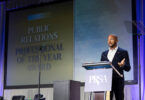Editor’s Note: The following is a guest post from Stefan Stern, a former management columnist for the Financial Times, who joined Edelman in July 2010 as director of strategy.
“So, tell me, how’s life on the ‘Dark Side’?”
I have been asked this question frequently over the last few months, usually (although not always) by journalists. After four happy years columnizing for the Financial Times, and after almost 20 years in total working as a journalist, last summer I took up a job in London with Edelman, the PR firm. After seven months in my new world, it seems like a good time to reflect on what I’ve found
I entered this business possessing some, if not all, of the prejudices that journalists have traditionally held against PR. Surely, I would be immersing myself in a world where some slippery, obstructive people spent their time on behalf of clients trying to hide embarrassing truths from the media, while distracting journalists’ attention with flimsy and banal “stories.” Everyone in the newsroom knows what those PR pros are like, right?
It would be an understatement to say that I have been pleasantly surprised by what I have found. Where I work — and, I am sure, Edelman is not alone in this — colleagues are hard working and knowledgeable. Of course, they are getting privileged, behind-the-scenes glimpses of their clients’ activities. Even so, I have been impressed by the seriousness and sophistication with which people approach their work. Frankly, they understand these businesses quite a bit better than some journalists do. I certainly feel I know a lot more about business now than I did eight months ago.
In fact, I have been longing for the chance — thank you, PRSA — to make this point. As far as I can see, this famous “dark side” really isn’t quite as dark as all that. Sure: clients sometimes make difficult and demanding requests. PR pros are asked to put the best possible gloss or, if you must, “spin,” on the facts. But that, I think, is not really very different from what a good lawyer (or advocate) would do. Are lawyers all working on the “dark side,” too? I don’t think so.
And then there is the world of journalism as it is currently practiced. Is that a shining beacon of light? The shocking behavior at the UK’s News of the World, exposed by The New York Times and The Guardian, is hardly a picture of moral rectitude. Tapping celebrities’ phone calls to produce scandalous headlines — now that really is dark.
And this week in London we learn that Private Eye, the venerable satirical magazine, has hired a — you guessed it — PR firm to help promote its 50th anniversary. Is that wicked? Is that dark? Of course not. It’s a sensible and practical way of working.
I have a lot more to learn, doubtless good and bad, about the PR industry. Clients will continue to make unreasonable demands, and at times fail, frustratingly, to grasp reality. Sometimes they will lack the courage to do the right thing. We will continue to try and make the best possible case for them — and turn down, rightly, any work that we feel unable to carry out. But “dark” this work certainly is not.
Good journalism shines a vital light on the world. We need it, badly. But bad journalism corrupts just as much as any obfuscating spin doctor. It possibly does even more harm, because the deception in that case is worse.
So: the next time someone asks me about life on the “dark side”, I will point them to the PRSA website, and then invite them to read this post.
Stefan Stern is director of strategy at Edelman in London and visiting professor at Cass Business School. He writes about management and communications at Stefan Stern on Management.
Related: A Glimpse Into the ‘Dark Side’ (PRSAY — June 10, 2010)







Stefan ~ Thank you for adding emphasis to my own earlier comments about ethics and public relations. You’re absolutely correct…it’s not the “industry” that is ethical or unethical…it’s the “individual” who makes that decision.
[…] The article can be read here. […]
I heard all that “dark side” nonsense after I moved from journalism to public relations in 2000. Here’s how I cured it. I grabbed a black marker and the nearest major newspaper I could find, and began circling the headlines for every story that clearly began life as a news release. The more headlines I circled, the quieter my critic got. Pretty soon, I stopped hearing anything about “going to the dark side.”
Here is journalism’s dirty little secret: The vast majority of news stories begin as news releases or story pitches. Indeed, news media would find it impossible to put out their products without the behind-the-scenes support of public relations professionals.
One other thing: I spent 20 years in the news business, and now 11 in public relations. If I went back to journalism, I would be a far better reporter now than I was then. Why? Because I’ve been inside the board rooms and I’ve listened to high-level conversations (business, politics, etc.), and now I have a far better idea of how the world REALLY works — and how to write about it.
Looks like you’ve seen the light Stefan. Enjoy the sun’s rays as I’m sure you’ll have a lot to contribute both to your clients and to your former colleagues in the press.
Stefan, thanks so much for sharing your perspective. I’ve been asked by journalists how and why I got into PR– and I’ve said it’s because I love journalism. At its heart, journalism is about storytelling, and that’s what any PR pro worth his or her salt should be doing.
PR provides the essential other side to a story, and today’s pros are more focused on honesty, clarity, transparency and positive change in their practice than ever before. I still can do many of the same activities that I loved as a reporter. It’s all about the story.